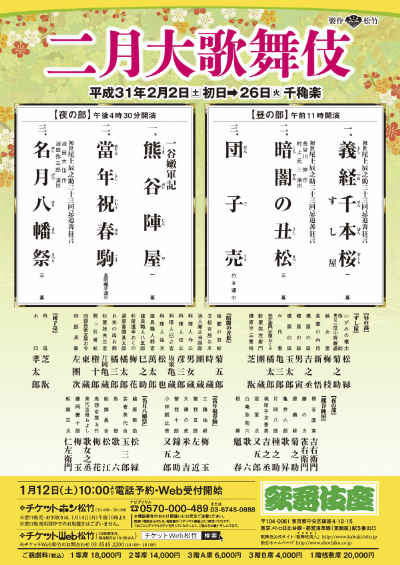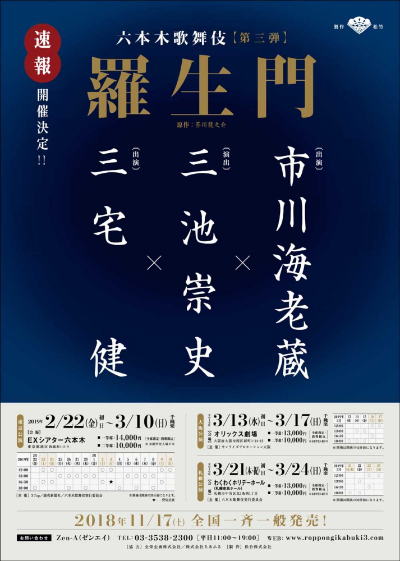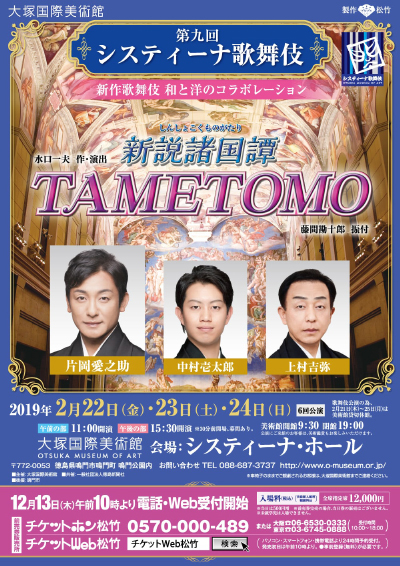| Casting |
Living National Treasure Onoe Kikugor˘, Living National Treasure Nakamura Kichiemon, Living National Treasure Band˘ Tamasabur˘, Living National Treasure Kataoka Nizaemon, Living National Treasure Nakamura T˘z˘, Nakamura Tokiz˘, Nakamura Jakuemon, Nakamura Shikan, Onoe Kikunosuke, Nakamura Baigyoku, Nakamura Kaishun, Onoe Sh˘roku, Kataoka Takatar˘, Nakamura Kinnosuke, Ichikawa Sadanji, Ichikawa Danz˘, Nakamura Karoku, Nakamura Matagor˘, Band˘ Hikosabur˘,
Band˘ Minosuke, Onoe Matsuya, Nakamura Baishi, Band˘ Shingo, Kataoka Kamez˘, Band˘ Kamez˘, Kawarasaki Gonjűr˘, Nakamura Matsue, Nakamura Kash˘, Nakamura Yonekichi, Nakamura Mantar˘, Nakamura Tanenosuke, Ichikawa Omez˘, Arashi Kitsusabur˘, Ichimura Kitsutar˘, Nakamura Kichinoj˘, Nakamura Baika, Nakamura Kamenoj˘, Ichikawa Otora, Nakamura Tamatar˘, Band˘ Kamesabur˘, Onoe Sakon
|
| Comments |
The February Grand Kabuki at the Kabukiza with 5 Living National Treasures: Onoe Kikugor˘, Nakamura Kichiemon, Band˘ Tamasabur˘, Kataoka Nizaemon and Nakamura T˘z˘!
Sushiya: this is one act of an epic originally written for the
Bunraku puppet theatre. The full-length play shows the fate of various
Taira generals in hiding after the victory of their enemy, the Genji.
In this act, Koremori (Onoe Kikunosuke), the heir to the Taira clan is hiding
in a sushi shop disguised as
a humble apprentice, and Osato (Nakamura Baishi),
the daughter of the house, falls in love with him. However, Gonta (Onoe Sh˘roku),
the evil son of the house plots to gain a reward by turning in
Koremori to the top Genji general Kajiwara (Nakamura Shikan), but in the end,
he has a surprising change of heart in one of the most heart-rending scenes
in Kabuki. Also featuring Ichikawa Danz˘ as Yazaemon, the proprietor of the sushi shop.
Kurayami no Ushimatsu: a modern masterpiece by Hasegawa Shin (1884~1963)
first performed in 1934. It shows Ushimatsu, an cook with a very strong sense of
justice who is forced to kill the evil stepmother of his lover Oyone.
Ushimatsu flees, but entrusts Oyone to Shirobŕ, his trusted workmate.
Some years later, he sneaks back into Edo, but on his way, he encounters Oyone
as a prostitute in an inn outside of town. She tries to explain that Shirobŕ
treacherously seduced her and then sold her into prostitution as soon as Ushimatsu
was gone. Ushimatsu refuses to listen to her, and heartbroken, Oyone commits suicide.
In the final scene, Ushimatsu goes to kill Shirobŕ as he is in the public bath.
This tense human drama is set against the details of common life in Edo:
a roadside inn, the backroom of a bathhouse, ... Starring Living National Treasure Onoe Kikugor˘ as Ushimatsu.
With Nakamura Tokiz˘ as Oyone and Ichikawa Sadanji as Shirobŕ. Featuring also Living National Treasure Nakamura T˘z˘, Ichikawa Danz˘, Band˘ Hikosabur˘, Kataoka Kamez˘ and Band˘ Kamez˘.
Dango Uri:
(The Dumpling Peddlers)
the mortar and pestle used for pounding rice cakes
and dumplings are a symbol of a happily married couple. This short, lively
dance shows a couple peddling dumplings with a series of songs and dances.
Starring Nakamura Shikan and Kataoka Takatar˘ in the roles of the husband and the wife.
Kumagai Jin'ya: this play is a dramatization of the clash between the Genji general Kumagai Jir˘ Naozane
and the Heike warrior Taira no Atsumori at the battle of Ichi-no-Tani, one of the most famous passages of the epic
"Tales of the Heike". In the Kabuki version, on the cryptic orders of the Genji leader Yoshitsune,
Kumagai hides the enemy warrior Atsumori and has his own son take the warrior's place.
On the battlefield, Kumagai has to kill his own son in Atsumori's place.
Things become worse when his wife Sagami and Atsumori's mother Fuji-no-Kata arrive at his camp.
In the highlight of the play, he tells them the story of his mortal battle with Atsumori, keeping Atsumori's well-being and his own sacrifice a secret.
He then shows the head of Atsumori for inspection by his leader to see if he has interpreted his orders correctly.
This performance stars Living National Treasure Nakamura Kichiemon as Kumagai,
with Nakamura Kaishun as Kumagai's wife Sagami,
Nakamura Jakuemon as Fuji-no-Kata,
Onoe Kikunosuke as Yoshitsune and
Nakamura Karoku as Midaroku.
Ataru Toshi Iwau Harukoma:
(Spring Hobbyhorses and the Soga Brothers)
The story of the revenge of the Soga brothers (sogamono)
is one of the favorite themes of Kabuki. Here it is transformed into a fanciful
dance using hobbyhorses, children's toys that were one of the sights of the
New Year. Starring Nakamura Baigyoku, Nakamura Kinnosuke and Nakamura Matagor˘.
Meigetsu Hachiman Matsuri:
(The Autumn Hachiman Festival)
Miyokichi (Living National Treasure Band˘ Tamasabur˘) is a spirited geisha in the Fukagawa
district with a distinguished lord as a patron and Sanji (Living National Treasure Kataoka Nizaemon), a good for nothing boatman, as
a lover. On the occasion of the Hachiman festival, she tries to raise an enormous
sum of money for Sanji, but refuses to try to get it from the patron who has been so good to her.
Instead, she tries to get it from the merchant Shinsuke (Onoe Sh˘roku).
Shinsuke has long been in love with Miyokichi and brings the money to make
her his own, but instead, she gets the money from her patron and so, has no
further interest in Shinsuke. When the ardent merchant learns that he has been
deceived, love turns to anger and he kills Miyokichi in a beautiful and gruesome
scene in the rain, under the full moon of the autumn festival.
Featuring also Nakamura Baigyoku and Nakamura Karoku.
Sources: Earphone Guide Website or Sh˘chiku Kabuki Official Website
|




